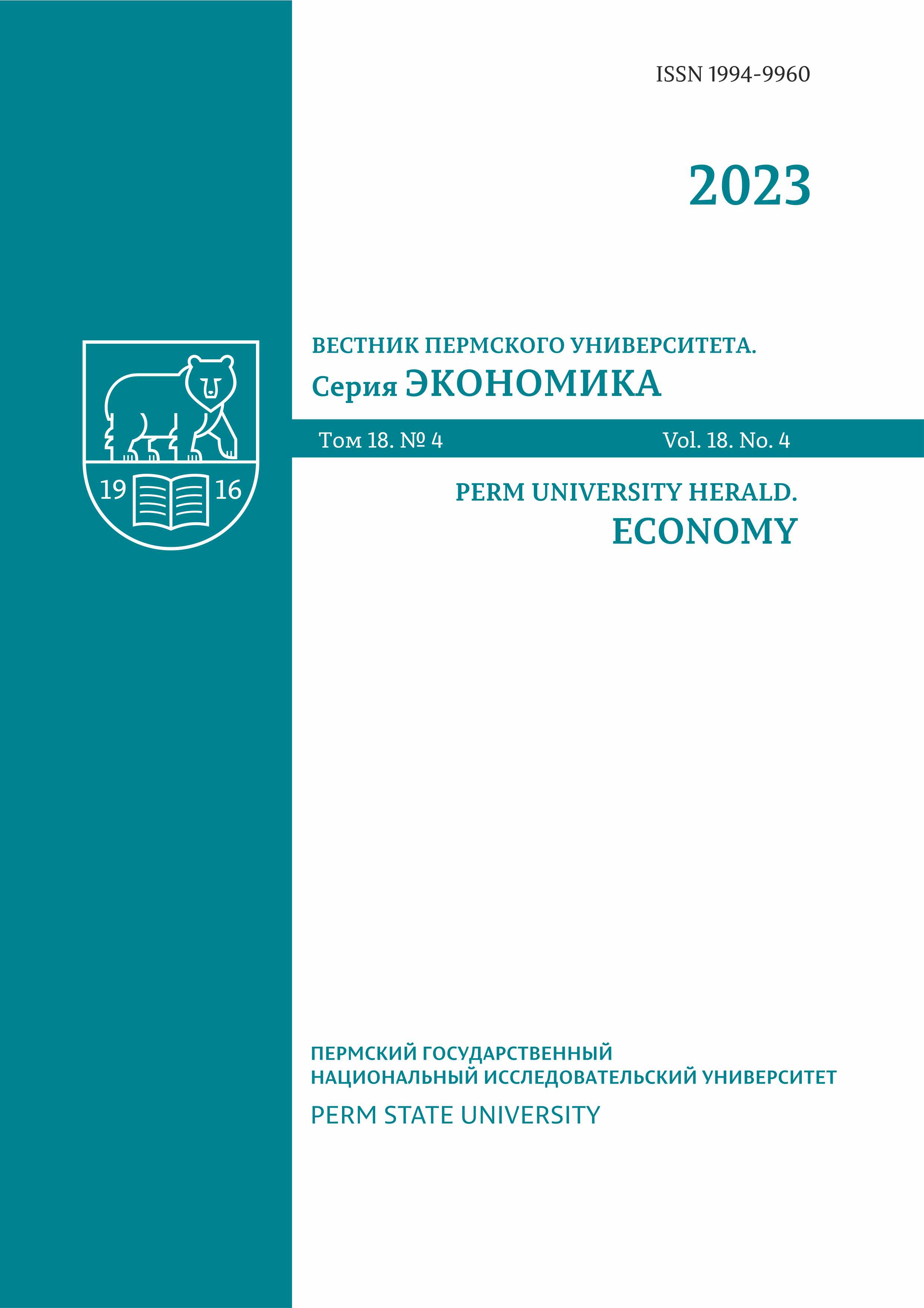The relationship between deferred taxes and current income tax accruals
DOI:
https://doi.org/10.17072/1994-9960-2023-4-445-472Abstract
Introduction. Accounting standards currently apply the principle imposing a 100 % probability of the existence of tax cash outflows on balance sheet deferred tax liabilities. However, this relationship has not been proven either theoretically or empirically in the accounting research literature, which determines the relevance of this study.
Purpose. The paper aims at testing the hypothesis which states that the reversal of deferred tax liabilities always increases income tax accruals. In order to achieve this goal, among other things, the relationship between the reversal of deferred tax assets and the change in current tax accruals was examined.
Materials and Methods. Traditional statistical analysis and standard techniques of econometric analysis were used – linear regressions and correlation matrices were constructed. Hypothesis was tested in the Russian organizations which reported under the 2012–2018 Russian accounting rules.
Results. At the “assets” scaling base, a 1 % increase in taxable temporary differences on average reduces taxable profit of the Russian organizations by almost 60 % (with a one-year lag – by 43 %). Restoration of deductible temporary differences at the “accounting profit before taxation” scaling base by 1 % on average leads to a 53.7 % decrease (with a one-year lag – by 67.8 %) in the taxable profit of the Russian organizations.
Conclusion. Recovery of an active deferred tax position has a more tangible impact on the change in taxable profit than reversal of a passive position. The developed methodological schemes assess the deferred tax position of companies, as well as compare them with each other by the level of accruals of profit tax and determine the reasons for their relative overstatement or understatement. Theoretical significance consists in the refutation of the principle laid down in paragraph 16 of IAS 12 Income Taxes, which indicates the relevance of clarifying the economic content of deferred taxes in accounting standards.
Keywords: accounting gaps, temporary differences, tax cash flows, deferred taxation, deferred tax liabilities, taxable income, reversal of temporary differences, taxable temporary differences
For citation
Aksent’ev A. A. The relationship between deferred taxes and current income tax accruals. Perm University Herald. Economy, 2023, vol. 18, no. 4, pp. 445–472. DOI 10.17072/1994-9960-2023-4-445-472. EDN TYGAUI.
References
- Bakke A., Kubick T. R., Wilkins M. S. Deferred tax asset valuation allowances and auditors’ going concern evaluations. Auditing: A Journal of Practice & Theory, 2023, vol. 42, no. 1, pp. 1–26. DOI 10.2308/AJPT-2020-063
- Aksent’ev А. А. Valuation allowance on deferred tax assets: Practice of registration and application. Vestnik NGUEU = Vestnik NSUEM, 2022, no. 3, pp. 102–127. (In Russ.). DOI 10.34020/2073-6495-2022-3-102-127. EDN LVPHTX.
- Brouwer A., Naarding E. Making deferred taxes relevant. Accounting in Europe, 2018, vol. 15, no. 2, pp. 200–230. DOI 10.1080/17449480.2018.1451903
- Chludek A. K. On the relation of deferred taxes and tax cash flow. SSRN, April 28, 2011. 52 p. DOI 10.2139/ssrn.1778265.
- Foster B. P., Ward T. J. The incremental usefulness of income tax allocations in predicting one-year-ahead future cash flows. The Journal of Applied Business Research, 2007, vol. 23, no. 4, pp. 37–48. DOI 10.19030/jabr.v23i4.1378.
- Laux R. C. The association between deferred tax assets and liabilities and future tax payments. The Accounting Review, 2013, vol. 88, no. 4, pp. 1357–1383. DOI 10.2308/accr-50417.
- Aksent’ev А. А. The theory of deferred taxation: Evidence of its applicability and conceptual framework. Vestnik Tomskogo gosudarstvennogo universiteta. Ekonomika = Tomsk State University Journal of Economics, 2022, no. 60, pp. 141–169. (In Russ.). DOI 10.17223/19988648/60/9. EDN IKUQAK.
- Schultz S. M., Johnson R. T. Income tax allocation: The continuing controversy in historical perspective. Accounting Historians Journal, 1998, vol. 25, issue 2, article 6. Available at: https://egrove.olemiss.edu/aah_journal/vol25/iss2/6/ access date 26.06.2022).
- Legoria J., Sellers K. F. The analysis of SFAS No. 109’s usefulness in predicting future cash flows from a conceptual framework perspective. Research in Accounting Regulation, 2005, vol. 18, pp. 143–161. DOI 10.1016/S1052-0457(05)18007-2.
- Atwood T. J., Drake M. S., Myers L. A. Myers Book-Tax Conformity, Earnings Persistence and the Association between Earnings and Future Cash Flows. Journal of Accounting and Economics, 2010, vol. 50, issue 1, pp. 111–125. DOI 10.1016/j.jacceco.2009.11.001.
- Aksent’ev А. А. Essence and classification of deferred taxes. Vestnik Permskogo universiteta. Seriya: Ekonomika = Perm University Herald. Economy, 2021, vol. 16, no. 4, pp. 421–448. (In Russ.). DOI 10.17072/1994-9960-2021-4-421-448. EDN EDTUGI.
- Colley R., Rue J., Volkan A. Deferred taxes revisited. Journal of Business & Economics Research, 2004, vol. 2, no. 8, pp. 13–24. DOI 10.19030/jber.v2i8.2907.
- Acheampong D., Valencia A., Volkan A. Industry specific impact of simplifying deferred taxes. Journal of Finance and Accountancy, 2013, vol. 13. 10 p.
- Breitkreuz R., Müßig A. Zur Zeitwertbilanzierung latenter Steuern in der internationalen Rechnungslegung. Zeitschrift für Betriebswirtschaft, 2011, vol. 81, pp. 1225–1256. DOI 10.1007/s11573-011-0515-2.
- Gallemore J. Deferred Tax Assets and Bank Regulatory Capital. Federal Deposit Insurance Corporation, September 2012. 59 p. Available at: https://www.fdic.gov/analysis/cfr/bank-research-conference/annual-12th/gallemore.pdf (access date 26.06.2022).
- Ladi O. M., Adediran S. A., Ude A. O. Book tax differences (BTDs) and financial distress of listed consumer goods firms in Nigeria. International Journal of Advanced Finance and Accounting, 2020, vol. 1, no. 2, pp. 31–51. Available at: https://airjournal.org/ijafa/wp-content/uploads/sites/13/2021/03/31-51.pdf (access date 26.06.2022).
- Noga T. Book-Tax Differences as an Indicator of Financial Distress. Accounting Horizons, 2013, vol. 27, no. 3, pp. 469–489. DOI 10.2139/ssrn.2159922
- Skinner D. J. The rise of deferred tax assets in Japan: The role of deferred tax accounting in the Japanese banking crisis. Journal of Accounting and Economics, 2008, vol. 46, issue 2-3, pp. 218–239. DOI 10.1016/j.jacceco.2008.07.003.
- Silva J. M., Souto N., Pereira J. A. Closed form solution for the valuation of deferred tax assets. Journal of Accounting and Taxation, 2021, vol. 13, no. 1, pp. 1–15. DOI 10.5897/JAT2020.0429
- Poterba J. M., Rao N. S., Seidman J. K. Deferred tax positions and incentives for corporate behavior around corporate tax changes. National Tax Journal, 2011, vol. 64, no. 1, pp. 27–57. DOI 10.17310/ntj.2011.1.02.











